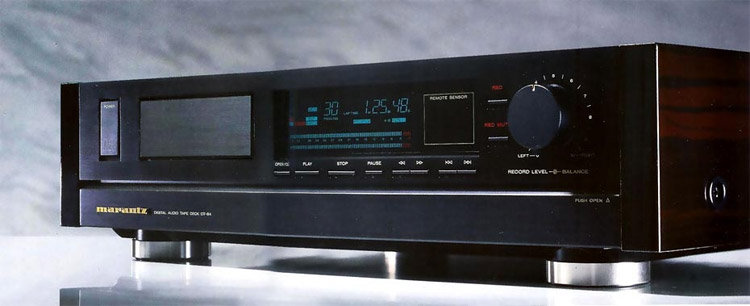The Marantz sister of the Philips DAT880 DAT recorder
DAT technology is similar to that utilized in compact discs, but instead of physical depressions on the disc, DAT uses magnetized sections of recording tape to represent the digital pulses. The pulses themselves constitute an intricate code that represents intensity measurements of individual sound waves. Each wave cycle in a musical performance is assigned a number in the digital code, and the numbers are stored on the recording tape, just as numbers are recorded on a computer disk.
Marantz DT-84 DAT recorder


Because the data on the tape is numeric rather than a direct analog audio signal, tape hiss, tape distortion, and even slight variations in tape speed cannot contaminate the sound. During playback, signals are created by a digital-to-analog converter reading the numbers on the tape and selecting corresponding signal voltage intensities. The result is a pure representation of the musical waveform as it appeared at the input.
The playback side uses 16 bit oversampling
D/A convertors, a 96 pole digital filter, and a 3 pole minimum phase, anti-aliasing output filter. True 16 bit A/D (analog to digital) convertors are used in the record section. The resulting 96 dB of dynamic range virtually eliminates background noise and permits you to record the most intense musical peaks without the fear of overload or distortion. With DAT, you can make perfect copies of prized old phonograph records or reel-to-reel tapes, you can make live recordings comparable to those made with digital mastering tape recorders, and you can make virtually perfect recordings from modern vinyl records and compact discs.
The convenient DAT cassette is only half the size of a standard cassette, yet it can hold two hours of continuous music. This is due to its advanced metal tape formulation and a high effective tape speed, or "writing-speed," of over nine teet per second — a speed made possible by the rapidly spinning head.


With DAT, individual tracks are much easier to access than on conventional tape decks. DAT requires no bias adjustments, no azimuth calibration, and no setting of recording level during direct digital record-ing. The digital data stream can be transmitted from one machine to another via a standard electrical connection or a fiber optical digital port.
With the introduction of the DT-84, the music lover finally possesses a recording medium that performs to the standards of the digital age, while incorporating the styling and remote control functions expected in an advanced consumer component.
 Block diagram Marantz DT-84
Block diagram Marantz DT-84
Specifications Marantz DT-84
- Twin 16-bit digital to analogue conversion
- Twin 16-bit analogue to digital conversion
- 4 times oversampling - digital filtering
- 48 kHz and 44.1 kHz sampling frequency
- 6 independent power supplies
- 4 direct drive motors
- Custom components
- Optical digital input and output
- Electronic digital input and output
- Random access programming
- Real-time counter (total/remaining/lap/lap remaining)